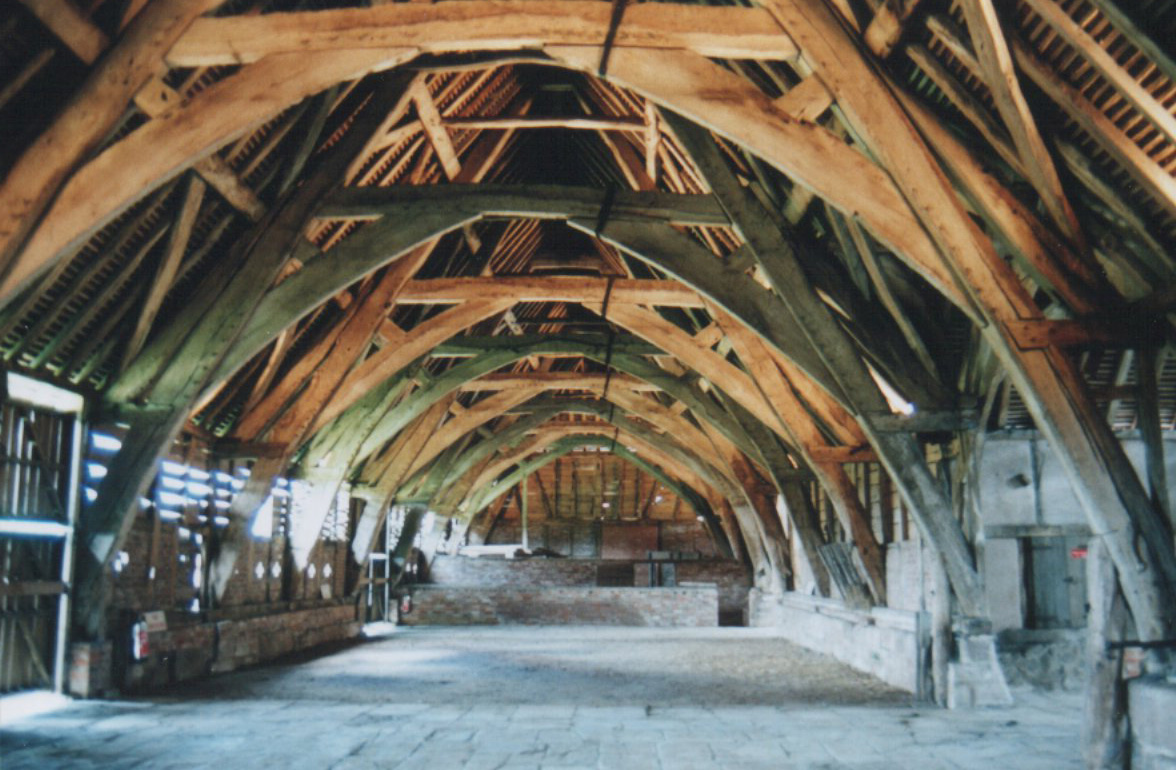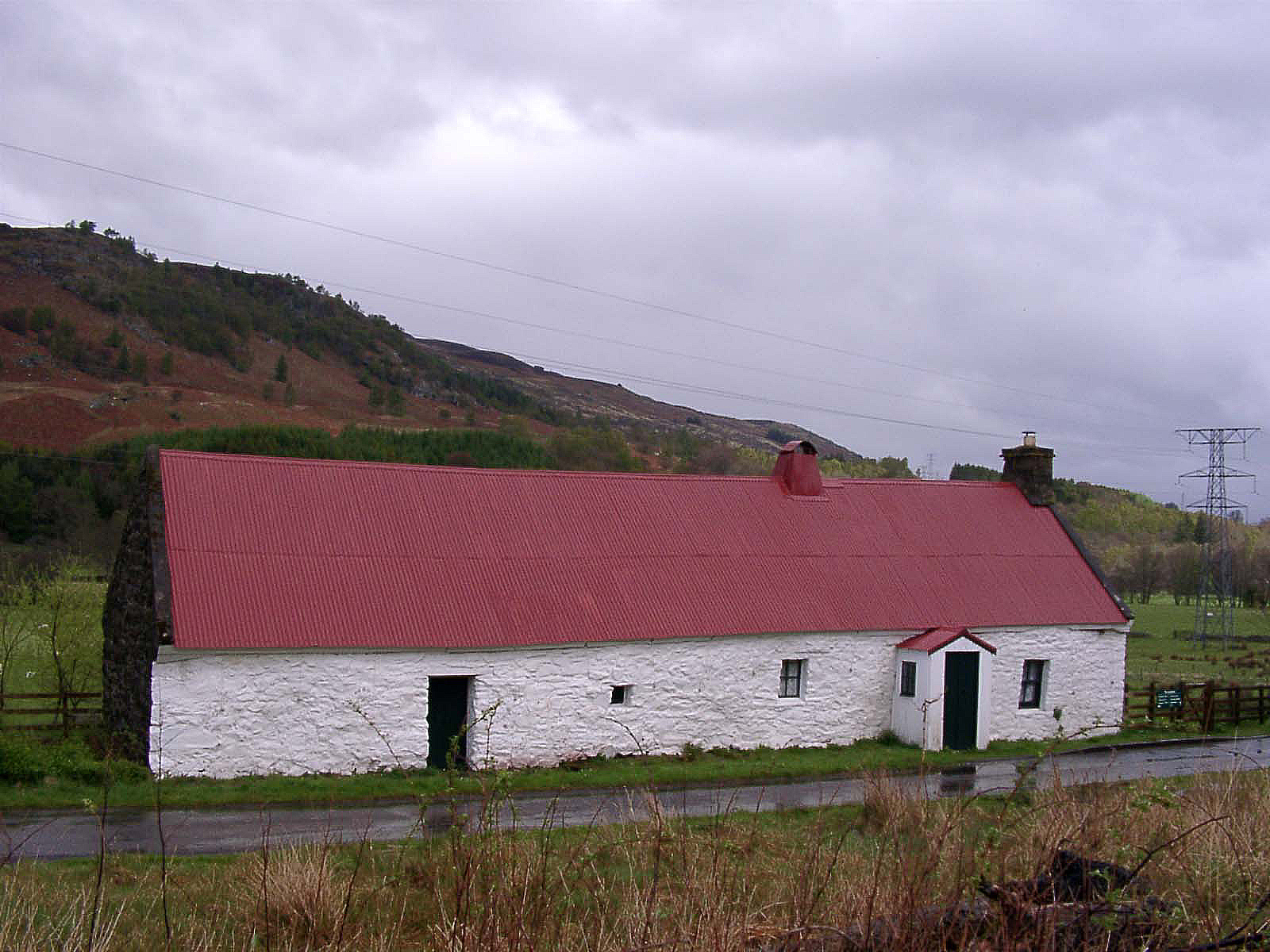cruck on:
[Wikipedia]
[Google]
[Amazon]

 A cruck or crook frame is a curved timber, one of a pair, which support the roof of a
A cruck or crook frame is a curved timber, one of a pair, which support the roof of a
 Crucks were chiefly used in the
Crucks were chiefly used in the
 # True cruck or full cruck: The blades, straight or curved, extend from a foundation near the ground to the ridge. A full cruck does not need a tie beam and may be called a "full cruck - open" or with a tie beam a "full cruck - closed".
# Base cruck: The tops of the blades are truncated by the first transverse member such as by a tie beam.
# Raised cruck: The blades land on masonry wall and extend to ridge.
# Middle cruck: The blades land on masonry wall and are truncated by collar beam.
# Upper cruck: The blades land on tie beam, very similar to knee rafters.
# Jointed cruck: The blades made from two pieces joined near eaves. They can be joined in at least five ways.
The apex of a cruck frame also helps to define the style and region of the cruck. Different types include the butt apex, halved, housed, yoke, and crossed forms.
# True cruck or full cruck: The blades, straight or curved, extend from a foundation near the ground to the ridge. A full cruck does not need a tie beam and may be called a "full cruck - open" or with a tie beam a "full cruck - closed".
# Base cruck: The tops of the blades are truncated by the first transverse member such as by a tie beam.
# Raised cruck: The blades land on masonry wall and extend to ridge.
# Middle cruck: The blades land on masonry wall and are truncated by collar beam.
# Upper cruck: The blades land on tie beam, very similar to knee rafters.
# Jointed cruck: The blades made from two pieces joined near eaves. They can be joined in at least five ways.
The apex of a cruck frame also helps to define the style and region of the cruck. Different types include the butt apex, halved, housed, yoke, and crossed forms.
Cruck database
Black and White Timber Framed houses
{{Woodworking Woodworking Vernacular architecture Timber framing Structural system

 A cruck or crook frame is a curved timber, one of a pair, which support the roof of a
A cruck or crook frame is a curved timber, one of a pair, which support the roof of a building
A building, or edifice, is an enclosed structure with a roof and walls standing more or less permanently in one place, such as a house or factory (although there's also portable buildings). Buildings come in a variety of sizes, shapes, and funct ...
, historically used in England and Wales. This type of timber framing consists of long, generally naturally curved, timber members that lean inwards and form the ridge of the roof. These posts are then generally secured by a horizontal beam which then forms an "A" shape. Several of these "crooks" are constructed on the ground and then lifted into position. They are then joined together by either solid walls or cross beams which aid in preventing 'racking' (the action of each individual frame going out of square with the rest of the frame, and thus risking collapse).
Etymology
The term ''crook'' or ''cruck'' comes fromMiddle English
Middle English (abbreviated to ME) is a form of the English language that was spoken after the Norman conquest of 1066, until the late 15th century. The English language underwent distinct variations and developments following the Old English ...
', from Old Norse ', meaning "hook". This is also the origin of the word "crooked", meaning bent, twisted or deformed, and also the crook used by shepherd
A shepherd or sheepherder is a person who tends, herds, feeds, or guards flocks of sheep. ''Shepherd'' derives from Old English ''sceaphierde (''sceap'' 'sheep' + ''hierde'' 'herder'). ''Shepherding is one of the world's oldest occupations, i ...
s and symbolically by bishops.
Use
 Crucks were chiefly used in the
Crucks were chiefly used in the medieval
In the history of Europe, the Middle Ages or medieval period lasted approximately from the late 5th to the late 15th centuries, similar to the post-classical period of global history. It began with the fall of the Western Roman Empire a ...
period for structures such as houses and large tithe barns, which were entirely timber-framed. They were also often used for the roofs of stone-walled buildings such as churches. However, these bent timbers were comparatively rare, as they were also in high demand for the shipbuilding industry.
Where naturally curved timbers were convenient and available, carpenters continued to use them at much later dates. For instance, base crucks are found in the roofs of the residential range of Staple Inn Buildings, Nos. 337 – 338, High Holborn, London. This is dated by documented records to 1586, with significant alterations in 1886 (under Alfred Waterhouse
Alfred Waterhouse (19 July 1830 – 22 August 1905) was an English architect, particularly associated with the Victorian Gothic Revival architecture, although he designed using other architectural styles as well. He is perhaps best known f ...
) and further restorations in 1936, and 1954–55. Despite these changes Cecil Hewett, an authority on English Historic Carpentry, has stated that these 16th-century crucks are original.
The large main barn of the manor house Barlow Woodseats Hall features what is claimed to be the longest continuously roofed cruck barn in Derbyshire, and possibly even in the United Kingdom.
An example of a Yorkshire cruck barn complete with a heather- thatched roof can be found in Appletreewick. The crucks or cruck "blades" are a single oak tree riven (split) in two to form an equally shaped A frame.
Rare examples of cruck framing are found on continental Europe such as in Belgium, Flanders, Northern France and the Corrèze region of France. No cruck frames are known to have been built in North America though there are rare examples of what may be an upper cruck or knee rafters.
Revival
During the current revival of green-oak framing for new building work, which has occurred mainly since approximately 1980 in the UK, genuine cruck frames have quite often been included in traditionally carpentered structures. There are also some fine, historically authentic reconstructions. For instance, Tithe Barn, Pilton, Glastonbury, whose original roof was destroyed by lightning, has been carefully rebuilt in 2005 from curved oaks. The necessary trees were sought out, using special templates, in English woodlands.Types
 # True cruck or full cruck: The blades, straight or curved, extend from a foundation near the ground to the ridge. A full cruck does not need a tie beam and may be called a "full cruck - open" or with a tie beam a "full cruck - closed".
# Base cruck: The tops of the blades are truncated by the first transverse member such as by a tie beam.
# Raised cruck: The blades land on masonry wall and extend to ridge.
# Middle cruck: The blades land on masonry wall and are truncated by collar beam.
# Upper cruck: The blades land on tie beam, very similar to knee rafters.
# Jointed cruck: The blades made from two pieces joined near eaves. They can be joined in at least five ways.
The apex of a cruck frame also helps to define the style and region of the cruck. Different types include the butt apex, halved, housed, yoke, and crossed forms.
# True cruck or full cruck: The blades, straight or curved, extend from a foundation near the ground to the ridge. A full cruck does not need a tie beam and may be called a "full cruck - open" or with a tie beam a "full cruck - closed".
# Base cruck: The tops of the blades are truncated by the first transverse member such as by a tie beam.
# Raised cruck: The blades land on masonry wall and extend to ridge.
# Middle cruck: The blades land on masonry wall and are truncated by collar beam.
# Upper cruck: The blades land on tie beam, very similar to knee rafters.
# Jointed cruck: The blades made from two pieces joined near eaves. They can be joined in at least five ways.
The apex of a cruck frame also helps to define the style and region of the cruck. Different types include the butt apex, halved, housed, yoke, and crossed forms.
See also
*Hammerbeam roof
A hammerbeam roof is a decorative, open timber roof truss typical of English Gothic architecture and has been called "...the most spectacular endeavour of the English Medieval carpenter". They are traditionally timber framed, using short beams pr ...
* Vernacular architecture
References
Further reading
* Hewett, Cecil A. (1980), ''English Historic Carpentry'', Philimore, pp 231–233. * Harris, Richard (1978), ''Discovering Timber-Framed Buildings'', Shire Publications Ltd. Princes Risborough, Buckinghamshire. * Alcock, N. W., Barley, M. W. ''et al'' (1996), ''Recording timber-framed buildings - An illustrated glossary'', Council for British Archaeology, York.External links
Cruck database
Black and White Timber Framed houses
{{Woodworking Woodworking Vernacular architecture Timber framing Structural system